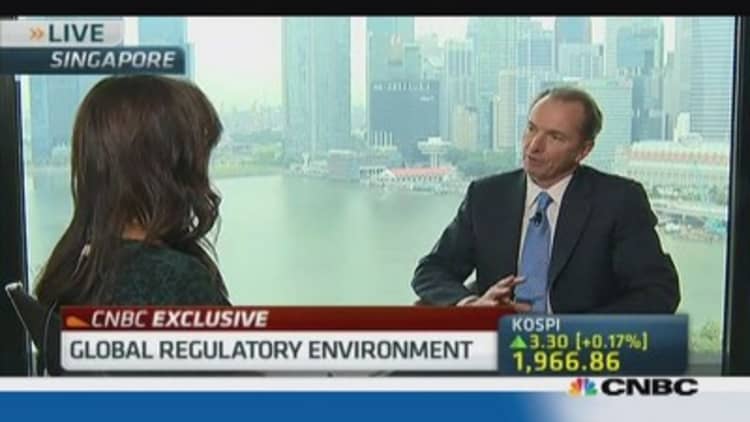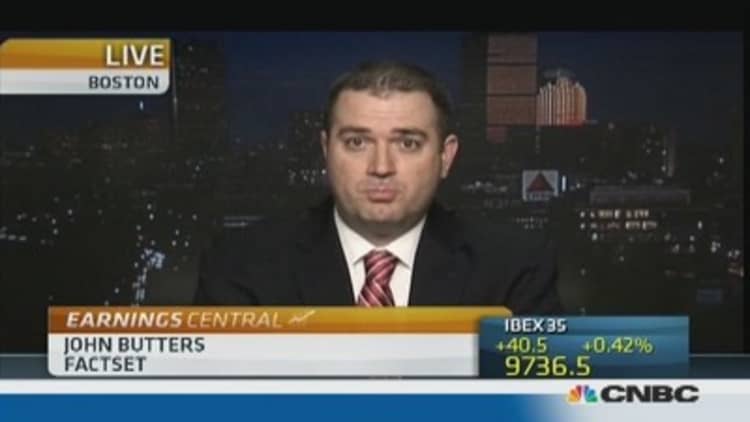Moody's has cut the credit ratings of big U.S. banks including Morgan Stanley, Goldman Sachs and JPMorgan Chase, after deciding that the federal government is less likely to bail the financial institutions out if they get into future difficulties.
Goldman, Morgan Stanley and JPMorgan had the ratings on their long-term senior unsecured debt lowered one notch to Baa1, Baa2 and A3, respectively, Moody's said on Thursday. The credit ratings on the three banks' subordinated debt were also cut by one notch.
The review by the second-largest rating agency, in terms of market share, follows a similar statement from rival Standard & Poor's in June, and comes as governments attempt to avoid a repeat of the bailouts of the credit crisis era.
(Read more: Citadel's Ken Griffin: I would break up the big banks)

Wall Street reforms under the Dodd-Frank Act forbid the use of taxpayer money to save a failing bank and require the creation of a resolution authority to wind down institutions once they get into trouble, imposing losses on creditors in the process.
"We believe that U.S. bank regulators have made substantive progress in establishing a credible framework to resolve a large, failing bank," said Robert Young at Moody's. "Rather than relying on public funds to bailout one of these institutions, we expect that bank holding company creditors will be bailed-in and thereby shoulder much of the burden to help recapitalise a failing bank."
(Read more: The problem with FedQE – Banks just aren't lending)
The lower credit ratings could raise the cost of capital for the banks, many of which were already downgraded by Moody's following another major review undertaken last year.

More from the Financial Times:
- Shadow banks reap Fed rate reward
- Critic's staff make overtures to US banks
- Regulators bicker over how to measure Dodd-Frank progress
At the time, bank executives argued bitterly that the wide-ranging downgrades were unfair and that the agency was overcompensating for optimism before the financial crisis.
This first review was designed to incorporate lessons from the crisis, when risks in banks' capital markets and trading businesses became evident. The agency warned at the time that it would re-evaluate its assumptions of US government support at a later date.
"Dodd-Frank is intended to end tax payer-funded bailouts of banks that's the rationale for Moody's rating actions," said Peter Nerby, vice-president at Moody's.

Moody's also cut the standalone baseline credit assessments of Bank of New York Mellon and State Street one notch to A1. The agency said the move reflected "the long-term profitability challenges" facing the two custodian banks.
The rating agency confirmed the senior holding company ratings of Bank of America, Citigroup, State Street and Wells Fargo. It upgraded the ratings of BofA and Citi subsidiaries, as well as their junior subordinated debt and preferred shares.
(Read more: The world's 10safest banks, ranked)
In after-hours trading the share prices of the banks initially fell on the news before recovering. Shares in Morgan Stanley were 0.7 per cent lower, Goldman Sachs was down 0.2 per cent, while JPMorgan had eased 0.1 per cent.
Morgan Stanley has been seen as the most vulnerable to credit rating downgrades. Thursday's downgrade takes the bank to two notches above "junk" status.
In its last quarterly filing, Morgan Stanley said it might have to post an additional $3bn in collateral to derivatives counterparties if it was downgraded to Baa2 by Moody's and to BBB by Standard & Poor's.
(Read more: Morgan Stanley hopes to expand share buyback program)
However, Morgan Stanley still has a higher rating by S&P so it will not have to post the full $3 billion. However, some of its contracts are based on the lower credit rating, giving those counterparties the option of demanding more cash or other high-quality collateral to back its trades.
"Over time they [credit ratings] tend to migrate within a notch of each other," says Glenn Schorr, bank analyst at ISI. "The market will price the debt of these companies – the ratings are an important input but they're only one input."

